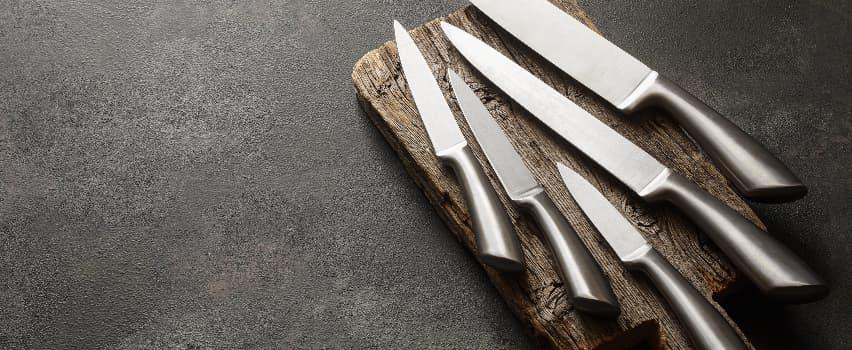How often do you need to replace your chef’s knives?
As you might expect, there’s no one-size fits-all answer to this question, as it typically depends heavily on exactly what knives you own, how often you use them, and what you use them for. Generally speaking though, you’ll probably need to replace your chef’s knives every five to ten years. Chefs knives and butchers knives that see heavy daily use in a busy commercial kitchen will (predictably) have a shorter lifespan than those used in households. Whatever the case though, what matters most is whether the knife can still deliver clean, precise cuts without unnecessary force. Once a knife no longer sharpens effectively or shows structural wear, it’s a safe bet that you’ll need to start looking at a replacement.
With more than 30 years of experience to our name here at Butchers Equipment Warehouse, we’re proud to be a one-stop shop for everything you need around cooking and butchery – so you can count on us to know the signs!
How to recognise when your knives need replacing
As we’ve briefly covered, different knives will have different lifespans, but here are some reliable signs that might indicate your knives are reaching their limit:
- The knife no longer holds an edge, even after sharpening
- Chips, cracks, or bends appear in the blade
- Food tears instead of slicing cleanly
- The handle feels loose, cracked, or uncomfortable
So, let’s examine each of them in a bit more detail. To start with, you can recognise when a knife needs replacing by paying attention to both its performance and its physical condition. A chef’s knife that has lost its ability to hold an edge (even after sharpening) generally signals that the blade steel has worn down past its best. Chips, cracks, or bends in the blade are also clear warnings that the knife is no longer safe or effective to use. A knife should glide smoothly through ingredients; if you find yourself pushing harder than usual, tearing food instead of slicing, or struggling with precision cuts, those are signs that the knife has reached the end of its service.
Another important indicator is the handle. A loose, cracked, or warped handle can easily compromise your grip and create safety risks in a fast-paced kitchen. For knives with wooden handles, these can swell or split because of exposure to water and cleaning chemicals over time, while synthetic handles may become brittle. Your knife should feel secure in your hand and balance comfortably when in use. If the handle no longer gives you that control, it’s better to replace the knife altogether rather than risk an uneven performance – or even injury.
3 factors that affect the lifespan of chef’s knives
The first factor is frequency of use. A chef in a professional kitchen who uses the same knife every day for hours at a time will wear down the edge much faster than someone cooking at home a few nights a week. Constant use means the blade is subject to repeated stress, frequent sharpening, and regular washing, all of which gradually reduce its lifespan.
The second factor is the type of steel used in the blade. High-carbon stainless steel knives tend to keep their edge longer and can be sharpened many times before they need to be replaced, while softer steel knives may wear down sooner. It’s one of the many reasons why it’s best to look for well-made knives at the outset, as it can play a big part in influencing how many years of use you’ll get before you need replacements.
The third factor is storage and care. Knives that are stored loose in a drawers can often develop nicks and dull spots on their blades, typically from knocking against other utensils. Proper storage in a knife block, magnetic strip, or dedicated roll can go a long way towards reducing that risk, and preserving the cutting edge. The way in which they’re cleaned is also another major factor; putting knives through a dishwasher exposes them to high heat and harsh detergents that can degrade both blade and handle. Instead, it’s best to wash them by hand and drying them immediately, ensuring they stay in good shape for longer.
How to care for your knives to extend their use
You can extend the working life of your knives by building consistent maintenance into your routine. Regular honing with a steel keeps the edge aligned between sharpenings, while professional sharpening restores a keen edge when the blade has dulled. If you can, avoid cutting on surfaces that damage the edge, such as glass or stone boards. Wooden or plastic chopping boards protect the blade and reduce wear, helping the knife stay sharper for longer.
As we’ve just touched on above, attention to cleaning makes a big difference too. Hand-wash your knives in warm, soapy water and dry them straight away to avoid rust spots and bacterial growth. Never leave them soaking in a sink, where the blade can become damaged or pose a hazard. Instead, store them carefully either in a protective block, sheath, or magnetic strip, so they don’t clash with other utensils. As well as preserving the edge, this also keeps your knives ready for efficient use each time you reach for them.
The 4 top benefits of a well-timed replacement
There are a variety of advantages associated with replacing your blades on time, but without question four of the most important are:
- Consistent performance in food preparation
- Safer handling with reduced risk of accidents
- Easier compliance with hygiene rules
- More comfortable use and higher productivity
First, a sharp, reliable blade generally reduces the physical effort required to prepare food and lets you make precise cuts that enhance both presentation and portion control. That kind of consistency also helps you to stay efficient when you’re preparing dishes at volume, since it helps you avoid wasting time struggling with cuts or redoing work because of poorly cut ingredients.
Second, prompt replacements can help maintain health and safety standards in your premises. As we’ve covered extensively in other articles here before at Butchers Equipment Warehouse, a dull or damaged knife is much more likely to slip while cutting, which increases the risk of serious injuries. A fresh, sharp blade on the other hand can properly grip ingredients, giving you more control and reducing accidents. New knives reduce strain on your hands and wrists too, since you don’t have to force cuts through tough ingredients.
Closely related to the safety element, there’s also the matter of maintaining food hygiene. Old knives with cracked handles or pitted blades can often harbour bacteria, making them harder to clean properly. It’s yet another reason why switching to new knives can help to keep your kitchen safer and more compliant with hygiene requirements. It can also prevent cross-contamination risks that come from food particles or moisture becoming trapped in damaged parts of an old knife.
Finally, using new knives can make your work more comfortable and productive. Modern designs often incorporate ergonomic handles and improved steel technology, which make them easier to use for long shifts. A knife that feels comfortable in your grip lets you work longer without fatigue, which is important when preparing large volumes of food. As a bonus, it can also help your team to work more effectively as a whole, since everyone can rely on tools that perform consistently.
That’s all the essentials covered! And of course, if you or any of your staff (new or otherwise) ever need any replacement chefs knives or butchers knives, you’re in exactly the right place. Here at Butchers Equipment Warehouse, we offer a wide range of butchery equipment and spare parts to ensure you’re fully prepared for the busy months ahead. Our products are designed to meet the rigorous demands of the industry, providing reliability and efficiency when you need it most. And of course, if you ever need any help or advice in choosing exactly the right equipment for you, you can always give us a call on 01254 427761. We’re here to help




